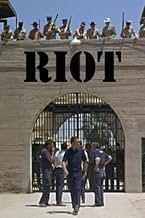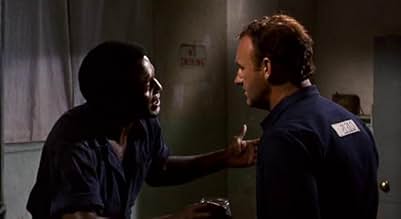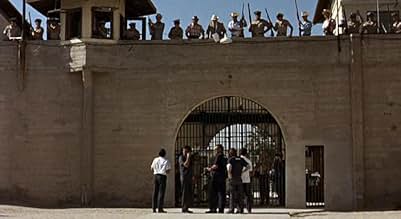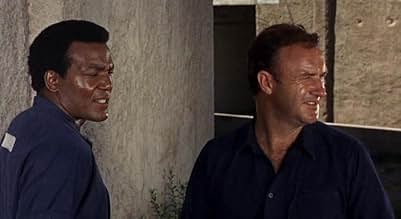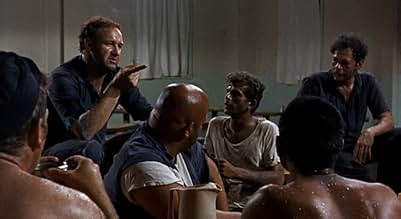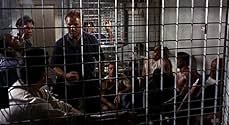Ajouter une intrigue dans votre langueA riot in a state prison is staged to cover up an escape attempt, during which many inmates and guards are killed. Shot on location at Arizona State Prison.A riot in a state prison is staged to cover up an escape attempt, during which many inmates and guards are killed. Shot on location at Arizona State Prison.A riot in a state prison is staged to cover up an escape attempt, during which many inmates and guards are killed. Shot on location at Arizona State Prison.
Avis à la une
"Riot" is a decent prison film, produced by William Castle (known as a director of things like "House on Haunted Hill") and directed by Buzz Kulik ('Brian's Song'). It stars Jim Brown, as cool as ever, as inmate Cully Briston, who realizes that the men of the isolation block have taken over that portion of the prison. Led by Red Fraker (Gene Hackman), they intend to pull off an escape, while pretending to the outside world to be petitioning for better conditions.
Ad copy may try to sell this as some kind of action film, but in truth it's more of a drama with some thriller elements. And it's NOT as violent as some people may fear, with some little bits of gore here and there. It doesn't attempt to show the lives of most of these inmates before their "riot". Cully has his misgivings about the whole thing, but gets caught up in it just the same, trying to talk some sense into Red.
The main asset of "Riot" is a degree of realism. It was based on a novel by Frank Elli, which was itself inspired by a real-life riot in a Minnesota prison. It features a number of inmates in supporting roles and bits, and even casts tough-as-nails real-life warden Frank Eyman to basically play himself. While it may not be truly action-packed, it has some great moments, especially the escape scenes near the end which are fraught with tension. The whole thing is professionally packaged, and nicely scored by Christopher Komeda.
Hackman is fun as the confident ringleader, while Brown remains highly watchable in his more even-keeled portrayal as a convict with some principles. Mike Kellin (who would return to the prison genre a decade later with "On the Yard"), Ben Carruthers (as the volatile, violent "Joe Surefoot"), and Clifford David (Beethoven in "Bill & Teds' Excellent Adventure") co-star as various inmates. Gerald S. O'Loughlin is good as a guard who's tried to dominate Cully for years, then turns weak after being used as a hostage.
"Riot" won't take a place as one of the great prison films, but it does entertain solidly for 97 minutes, which is all you can really ask for sometimes.
Seven out of 10.
Ad copy may try to sell this as some kind of action film, but in truth it's more of a drama with some thriller elements. And it's NOT as violent as some people may fear, with some little bits of gore here and there. It doesn't attempt to show the lives of most of these inmates before their "riot". Cully has his misgivings about the whole thing, but gets caught up in it just the same, trying to talk some sense into Red.
The main asset of "Riot" is a degree of realism. It was based on a novel by Frank Elli, which was itself inspired by a real-life riot in a Minnesota prison. It features a number of inmates in supporting roles and bits, and even casts tough-as-nails real-life warden Frank Eyman to basically play himself. While it may not be truly action-packed, it has some great moments, especially the escape scenes near the end which are fraught with tension. The whole thing is professionally packaged, and nicely scored by Christopher Komeda.
Hackman is fun as the confident ringleader, while Brown remains highly watchable in his more even-keeled portrayal as a convict with some principles. Mike Kellin (who would return to the prison genre a decade later with "On the Yard"), Ben Carruthers (as the volatile, violent "Joe Surefoot"), and Clifford David (Beethoven in "Bill & Teds' Excellent Adventure") co-star as various inmates. Gerald S. O'Loughlin is good as a guard who's tried to dominate Cully for years, then turns weak after being used as a hostage.
"Riot" won't take a place as one of the great prison films, but it does entertain solidly for 97 minutes, which is all you can really ask for sometimes.
Seven out of 10.
Buzz Kulik's pulpy, lurid Riot, an R-rated glob of clichéd prison- flick trash shows us two things:
1. Since this would be PG-13 now, with almost dirty language, sort- of naked prisoners being beaten, sparing gouts of blood, and way, way too much of a gay prisoner doing a bump and grind in his cell, one can marvel at how our tolerance of crudity has risen over the last five decades. Kulik must have been in constant combat with the standards and practices folks at Paramount, either to put more movies-sure-are-different adult stuff in this story of a riot masking an escape in an Arizona prison, or to clean this thing up, now!
2. Kulik's ability to take such a nasty, ugly, and pretty-much stupid prison-break story and infuse it with a professionalism the movie doesn't deserve is a testament to his talent. Jim Brown and Gene Hackman, along with a number of recognizable character actors and a whole bunch of real-life inmates are either catatonic or chew up scenery at an alarming rate. The stuff that comes out of their mouths could only be called dialogue in the most general sense of the word. In other words, Riot is a blob of sweat-covered clichés that, for some reason, is watchable enough to keep watching. Go figure!
I saw Riot the first time in, I think, 1973 when ABC showed it during the summer down-time. I could tell the movie had about a third lopped out for all the crudities and nudities and other prisonese. I could only imagine what the little old ladies with the pinking shears and the blue hair at ABC were snipping out, but I thought it was a pretty fearsome movie anyway.
Now, I just marvel at how far Riot pushes the edge of the envelope.
It's still a crappy movie, but it's also a snapshot of what a movie studio was willing to allow for public consumption, way back when you couldn't say "damn" on TV.
1. Since this would be PG-13 now, with almost dirty language, sort- of naked prisoners being beaten, sparing gouts of blood, and way, way too much of a gay prisoner doing a bump and grind in his cell, one can marvel at how our tolerance of crudity has risen over the last five decades. Kulik must have been in constant combat with the standards and practices folks at Paramount, either to put more movies-sure-are-different adult stuff in this story of a riot masking an escape in an Arizona prison, or to clean this thing up, now!
2. Kulik's ability to take such a nasty, ugly, and pretty-much stupid prison-break story and infuse it with a professionalism the movie doesn't deserve is a testament to his talent. Jim Brown and Gene Hackman, along with a number of recognizable character actors and a whole bunch of real-life inmates are either catatonic or chew up scenery at an alarming rate. The stuff that comes out of their mouths could only be called dialogue in the most general sense of the word. In other words, Riot is a blob of sweat-covered clichés that, for some reason, is watchable enough to keep watching. Go figure!
I saw Riot the first time in, I think, 1973 when ABC showed it during the summer down-time. I could tell the movie had about a third lopped out for all the crudities and nudities and other prisonese. I could only imagine what the little old ladies with the pinking shears and the blue hair at ABC were snipping out, but I thought it was a pretty fearsome movie anyway.
Now, I just marvel at how far Riot pushes the edge of the envelope.
It's still a crappy movie, but it's also a snapshot of what a movie studio was willing to allow for public consumption, way back when you couldn't say "damn" on TV.
8tavm
While I had watched this movie previously in the '90s, I forgot many of the details such as a dream sequence of Jim Brown being surrounded by a bevy of young black women in bikinis at a swimming pool or the following scene of the homosexual prisoners dressing up in drag. Quite exciting especially during the second half when the warden returns from his vacation and decides to fire away, his staff being held hostage damned. And, yes, Gene Hackman is also very good as a fellow prisoner who instigated the whole thing with Brown being a reluctant participant. So on that note, Riot is highly recommended. P.S. That Bill Medley song sure is hauntingly effective every time it plays on the score.
I realized in time for his centenary tribute that this tense jailbreak thriller was produced by William Castle; the film does not have much of a reputation, however, and is perhaps most notable for being one of a number of transitory parts for Gene Hackman between his acquiring fame in BONNIE AND CLYDE (1967) and stardom via THE FRENCH CONNECTION (1971) – another such effort, THE SPLIT (1968), had partnered him with Jim Brown (who also assumes the leading role here). Indeed, Hackman's superiority in the acting stakes – despite essentially playing second- fiddle to ex-American Football luminary Brown – in comparison to the other participants (more on this later) is palpable throughout. Having said that, Gerald S. O'Loughlin is initially set out as the prisoners' chief nemesis but his contribution gradually diminishes once the titular event takes centre-stage.
The movie is basically an updated and more brutal version of earlier prison dramas, the obvious prototype being Don Siegel's noir classic RIOT IN CELL BLOCK 11 (1954). What is interesting in this case is that the riot is borne out of an attempted mass escape of the isolation division; when the latter is foiled, mastermind Hackman decides to buy some time – ostensibly negotiating system reforms with the authorities on the outside (as it happens, the fearsome warden has chosen this precise moment to take a break!) – while a tunnel is being laboriously dug from under the auditorium to freedom just past the walls of the vast compound!! Incidentally, Castle is to be commended for shooting this in an authentic Arizona correctional facility – with not only the real-life warden filling his respective shoes within the narrative (I wonder whether he was aware of how unsympathetically his office was being depicted!) but also a number of the convicts themselves!!
As I said, the film features a number of contemporary trappings which, frankly, do it (and even more so the genre involved) no more than a disservice – notably a substance-fuelled party by the inmates, with a handful of them in drag so as to titillate their 'colleagues'; one of them even invites coloured macho Brown to his cell, but he obviously backs off (preferring to envision a clutch of bikini-clad 'sisters' in the movie's one scene with female presences, drooling over him)! Similarly over-the-top are the actions of a wacky knife-happy Indian who constantly antagonizes Brown, and whom Hackman needs tagging along in order to supply guidance in their eventual flight to Mexico only to have his throat memorably slit by him at their very moment of glory (many of the intended fugitives had already been routed by the shrewd warden)! Among the assets, then, are the pristine DVD-sourced look and Krzysztof Komeda's unusual score (albeit backed by a recurring wistful ballad that acts as Brown's theme tune), the esteemed Polish composer's last effort prior to his untimely tragic death – and which ties the picture with Castle's much more distinguished production ROSEMARY'S BABY (1968).
The movie is basically an updated and more brutal version of earlier prison dramas, the obvious prototype being Don Siegel's noir classic RIOT IN CELL BLOCK 11 (1954). What is interesting in this case is that the riot is borne out of an attempted mass escape of the isolation division; when the latter is foiled, mastermind Hackman decides to buy some time – ostensibly negotiating system reforms with the authorities on the outside (as it happens, the fearsome warden has chosen this precise moment to take a break!) – while a tunnel is being laboriously dug from under the auditorium to freedom just past the walls of the vast compound!! Incidentally, Castle is to be commended for shooting this in an authentic Arizona correctional facility – with not only the real-life warden filling his respective shoes within the narrative (I wonder whether he was aware of how unsympathetically his office was being depicted!) but also a number of the convicts themselves!!
As I said, the film features a number of contemporary trappings which, frankly, do it (and even more so the genre involved) no more than a disservice – notably a substance-fuelled party by the inmates, with a handful of them in drag so as to titillate their 'colleagues'; one of them even invites coloured macho Brown to his cell, but he obviously backs off (preferring to envision a clutch of bikini-clad 'sisters' in the movie's one scene with female presences, drooling over him)! Similarly over-the-top are the actions of a wacky knife-happy Indian who constantly antagonizes Brown, and whom Hackman needs tagging along in order to supply guidance in their eventual flight to Mexico only to have his throat memorably slit by him at their very moment of glory (many of the intended fugitives had already been routed by the shrewd warden)! Among the assets, then, are the pristine DVD-sourced look and Krzysztof Komeda's unusual score (albeit backed by a recurring wistful ballad that acts as Brown's theme tune), the esteemed Polish composer's last effort prior to his untimely tragic death – and which ties the picture with Castle's much more distinguished production ROSEMARY'S BABY (1968).
RIOT is a 1969 shoestring B production that looks like a made for TV time-passer with Jim Brown at the top of his game, and Gene Hackman, fresh from his small but eye-catching part in BONNIE AND CLYDE (1967) on his way up, with stardom assured two years later as copper Popeye Doyle in FRENCH CONNECTION. The two men had already appeared together in THE SPLIT (1968)
Substandard photography does not hurt the film, rather adding to its credibility as a tale about a breakout from a dingy jail with inhuman guards. Good singing from Bill Medley - great voice - as part of somewhat uneven score. Generally effective dialogue ahead of its time by including gay prisoners, shocking ending.
Competent direction from William Castle, who made his name in horror movies but does a competent job with RIOT. 7/10.
Substandard photography does not hurt the film, rather adding to its credibility as a tale about a breakout from a dingy jail with inhuman guards. Good singing from Bill Medley - great voice - as part of somewhat uneven score. Generally effective dialogue ahead of its time by including gay prisoners, shocking ending.
Competent direction from William Castle, who made his name in horror movies but does a competent job with RIOT. 7/10.
Le saviez-vous
- AnecdotesArizona State Penitentiary warden Frank Eyman and 600 inmates and prison staff appear in the movie.
- Versions alternativesAn edited, "PG" rated version was released to theaters in 1970. Video version is the complete "R" rated version.
- ConnexionsReferenced in Summer in the City (1971)
- Bandes originalesRAG MOP
Words and Music by Johnny Lee Wills and Deacon Anderson
Meilleurs choix
Connectez-vous pour évaluer et suivre la liste de favoris afin de recevoir des recommandations personnalisées
- How long is Riot?Alimenté par Alexa
Détails
- Durée
- 1h 36min(96 min)
- Mixage
- Rapport de forme
- 1.85 : 1
Contribuer à cette page
Suggérer une modification ou ajouter du contenu manquant

